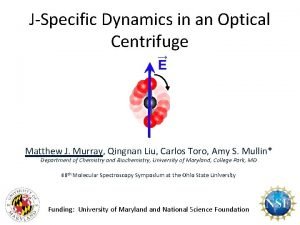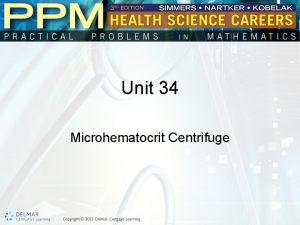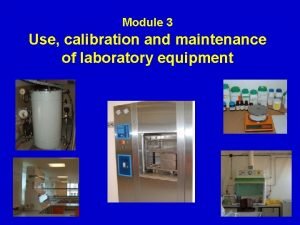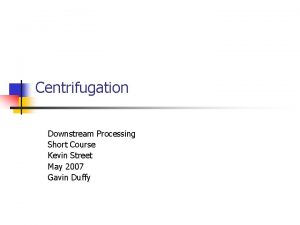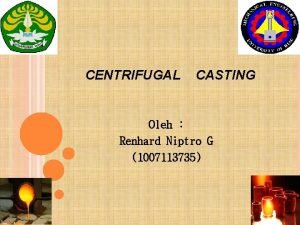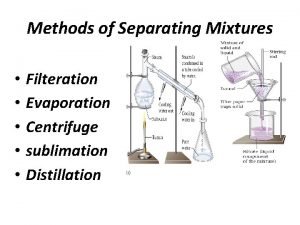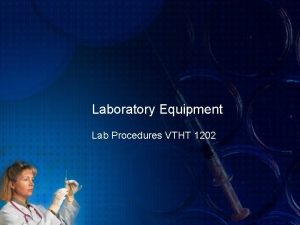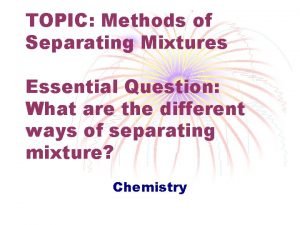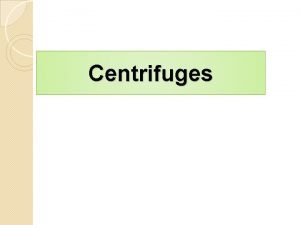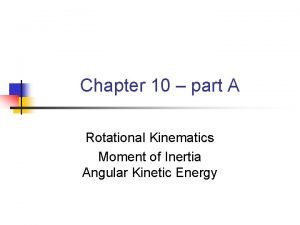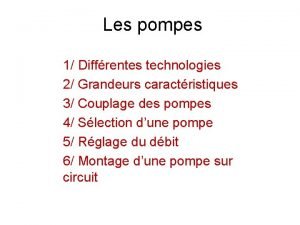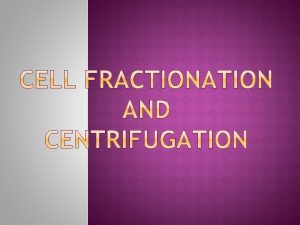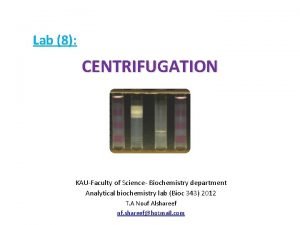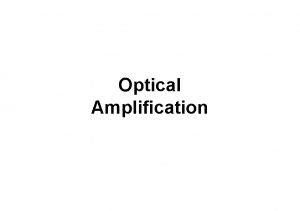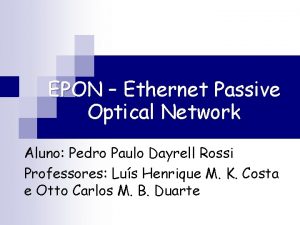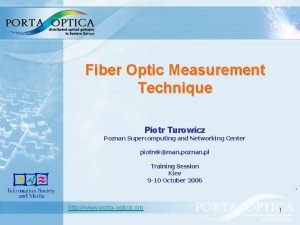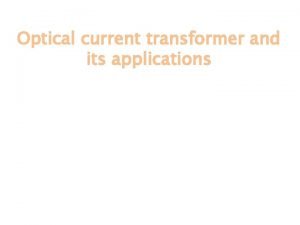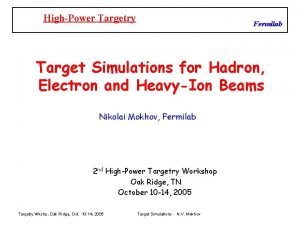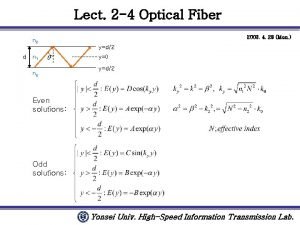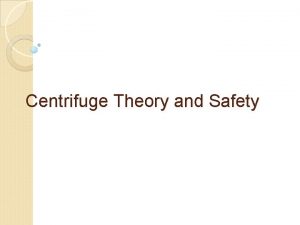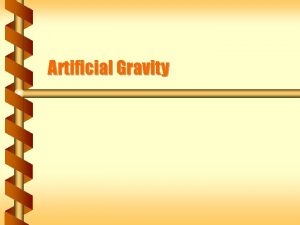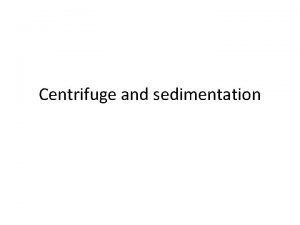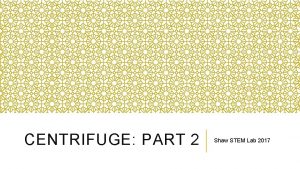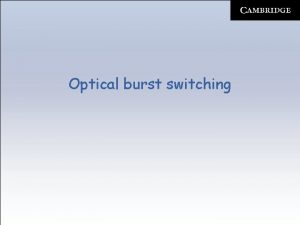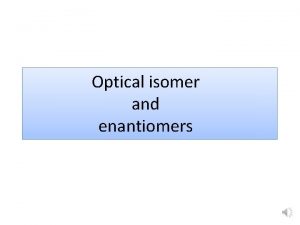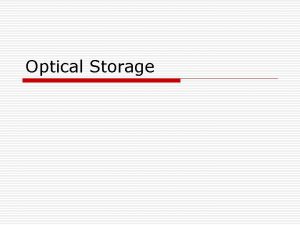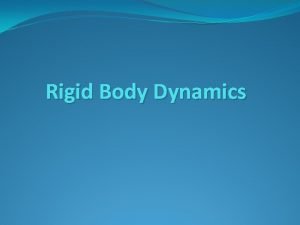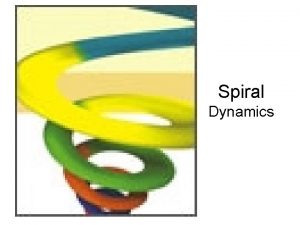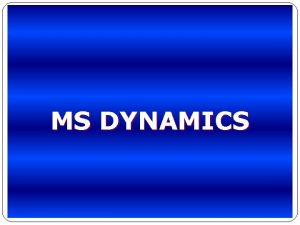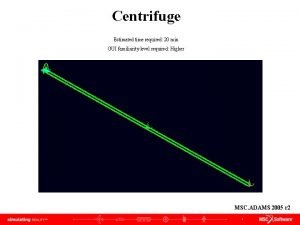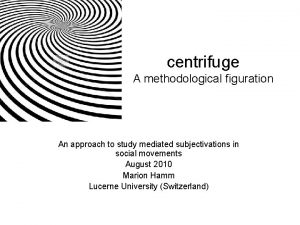JSpecific Dynamics in an Optical Centrifuge Matthew J
























- Slides: 24

J-Specific Dynamics in an Optical Centrifuge Matthew J. Murray, Qingnan Liu, Carlos Toro, Amy S. Mullin* Department of Chemistry and Biochemistry, University of Maryland, College Park, MD 68 th Molecular Spectroscopy Symposium at the Ohio State University Funding: University of Maryland National Science Foundation

Extreme Orientation of Molecules An optical centrifuge drives molecules to ultra-high rotational states with oriented angular momentum—a single MJ. Compared to Keller, A. , Control of the Molecular Alignment or Orientation by Laser Pulses. In Mathematical Horizons for Quantum Physics, 2010.

Operating Principles of the Optical Centrifuge Interaction energy • A molecule with an anisotropic polarizability, Da, aligns with the electric field. • During the optical centrifuge pulse, the electric field angularly accelerates from 0 to 1013 rad/sec. Karczmarek, J. ; Wright, J. ; Corkum, P. ; Ivanov, M. , Optical centrifuge for molecules. Phys. Rev. Lett. 1999, 82 (17), 3420 -3423.

Creating an Optical Centrifuge Two oppositely-chirped 800 nm pulses, each with opposite circular polarization Create a linear electric field which angularly accelerates Yuan, L. W. ; Toro, C. ; Bell, M. ; Mullin, A. S. , Spectroscopy of molecules in very high rotational states using an optical centrifuge. Faraday Discuss. 2011, 150, 101 -111.

Previous Optical Centrifuge Studies of CO 2 Transient IR absorption: appearance of J=76 followed by relaxation (10 Torr) “prompt” rise is pressure-dependent: collision-induced transient signals Detector Response Yuan, L. W. ; Teitelbaum, S. W. ; Robinson, A. ; Mullin, A. S. , Proc. Natl. Acad. Sci. U. S. A. 2011, 108 (17),

J-Specific Dynamics in the Optical Centrifuge 300 K distribution Goal: Study the dynamics of a broad range of rotational states after the optical centrifuge pulse excites a sample In this work we look at the dynamics of J=76, 54, 36, and 0.

Quantum-resolved Transient IR Absorption of CO 2 + Optical Centrifuge → CO 2 (0000, J≈220) CO 2(0000, J≈220) + CO 2(300 K) → CO 2(0000, J) + CO 2(0000, J’) High-J Probing CO 2(0000, J) + IR → CO 2(0001, J± 1) Low-J Probing CO 2(0000, J) + IR → CO 2(1001, J± 1)

Optical Centrifuge and High Resolution Transient IR Spectrometer Energy: 50 m. J/pulse Pulsewidth: 100 ps Beam waist: 26 µm Rep. Rate: 10 Hz OPO* λ~2. 7 µm Diode Laser λ~4. 3 µm *Optical Parametric Oscillator

Assessment of Strong Field Phenomena Compare transient absorption for CO 2 J=76 with same total power (~35 m. J/pulse)

Transient Absorption Measurements of CO 2 J=54 and 76 J=76 t’=290 ns J=54 t’=2. 0 ms t”=21 ms t”=4. 5 ms • Transient appearance then decay is seen for both states • J=76 appearance is ~10 x faster than J=54 • Collision-induced decay of J=76 is ~5 x faster than J=54

Doppler Broadened Transient Absorption Line Profile Early Time Translational Temperatures of J=76 Long Time Translational Temperatures τ1=170 ns τ2=7. 2 µs 10 ns between collisions at 10 Torr

Doppler Broadened Transient Absorption Line Profile of J=54 Early Time Translational Temperatures Long Time Translational Temperatures

Time Dependent Temperatures and Populations for J=76 and J=54 τA=1. 3 µs J=54 τR=31 µs J=76 J=54 τA=240 ns J=76 Both J=76 and J=54 show molecules appear into these states with large translational energies. τR=1. 8 µs

Transient Absorption Measurements of CO 2 J=36 Depletion at line center Raw Transient Smoothed Transient Appearance in wings

Doppler Broadened Transient Absorption Line Profile of J=36 Appearance Depletion 20 ns between collisions at 5 Torr

Time Dependent Temperature and Population for CO 2 J=36 τA=2. 5 µs τD=1. 2 µs Molecules appear into J=36 with high translational energy and those that leave the state have low translational energy. The rates at which population enters and leaves J=36 are only ~2 x different.

Transient Absorption of CO 2 J=0

Doppler Broadened Transient Line Profile of CO 2 J=0 Early Time Translational Temperatures Long Time Translational Temperatures τ=1. 9 µs

Time Dependent Temperature and Population for J=0 τD=1. 25 µs τR=110 µs We see molecules being depleted from J=0 and J=36 are from a slower subset of molecules in the initial 300 K ensemble. Population recovery of J=0 is relatively slow.

3 -State Rotational Distribution Trot Decay ~32 Collisions Use appearance population from J=76, 54, and 36.

Quasi-Equilibrium at 550 K J=54 J=0 Conservation of energy indicates that ~2% of CO 2 molecules are initially excited by the optical centrifuge to J ~220

Summary Ø We have used high resolution transient IR absorption to investigate the J-dependent behavior in an optical centrifuge. Ø We see evidence for fast translational energy gain followed by relaxation due to collisions in the optical centrifuge. Ø Results show evidence for long-lived energy content in molecules. Ø J-dependent profiles show the rotation to rotationtranslation energy transfer process through a collisional cascade. The CO 2 molecules reach a quasi-equilibrium temperature of ~550 K.

Quasi-Equilibrium at 550 K Erot = Centrifuge-Induced Rotational Energy NJ = Number Density of Centrifuged Molecules J=54 J=0 Ntot = Total number density in cell Ti = 300 K Tf ≈ 550 K

Depletion Transient Absorption from Low J
 Optical centrifuge
Optical centrifuge Microhematocrit centrifuge principle
Microhematocrit centrifuge principle Maintenance of incubator
Maintenance of incubator Centrifuge definition medical
Centrifuge definition medical Disk stack centrifuge sigma factor
Disk stack centrifuge sigma factor Semi centrifugal casting
Semi centrifugal casting Centrifugation separating mixtures
Centrifugation separating mixtures Centrifuge machine
Centrifuge machine Vm1650 centrifuge basket
Vm1650 centrifuge basket Centrifuge equation
Centrifuge equation Different methods of separating mixtures
Different methods of separating mixtures Use of centrifuge
Use of centrifuge A centrifuge in a medical laboratory rotates
A centrifuge in a medical laboratory rotates Centrifuge equation
Centrifuge equation Principles of centrifugation
Principles of centrifugation Pompe centrifuge
Pompe centrifuge Centrifugation theory
Centrifugation theory Centrifuge
Centrifuge Edfa gain spectrum
Edfa gain spectrum Gigabit ethernet passive optical network
Gigabit ethernet passive optical network Impulsreflektometer
Impulsreflektometer Moct
Moct Optical retail industry
Optical retail industry Target optical near me
Target optical near me V number in optical fiber
V number in optical fiber
